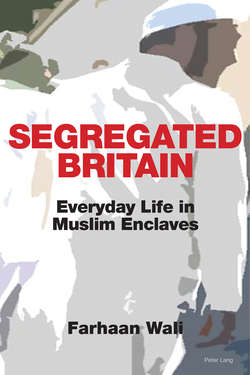Segregated Britain

Реклама. ООО «ЛитРес», ИНН: 7719571260.
Оглавление
Farhaan Wali. Segregated Britain
Отрывок из книги
SEGREGATED BRITAIN
Everyday Life in Muslim Enclaves
.....
This is greatly compounded by the broad struggle of young Muslims ‘to discover how to be a Muslim as a minority in a non-Muslim society’ (Lewis, 2007, p. 6). Stratham (2003) equates the rise in overt religious affiliation amongst some Muslims to two interconnected social realities: (1) Islam seeks to assert itself within the public realm, and (2) Muslim identity formation is an acute response to social deprivation and discrimination. In regards to the latter, Muslim self-consciousness is often reinforced by negative media stereotypes. The public vilification of Muslim belief and practice tends to lead to introverted responses: ‘Muslim communities closing ranks’ (Samad, 1996, p. 97). Similarly, Ballard (1996) believes the marginalisation of Muslims from the majority culture has triggered a reaffirmation of religion. This is because young Muslims perceive their religious identity to be under constant threat, and not their ethnicity, resulting in greater mobility towards Muslim identity. This movement away from ethno-identity labels is exacerbated by the declining attachment to South Asia, as a cultural and linguistic reference point. As Samad (2004, p. 17) suggests, ‘identification with Pakistan and Bangladesh – countries that young people may only briefly visit – becomes less significant and Muslim as an identity becomes more important’. In this respect, religious identity, Gardner and Shuker (1994, p. 164) explain, ‘provides both a positive identity, in which solidarity can be found, together with an escape from the oppressive tedium of being constantly identified in negative terms’.
The examination of religious affiliation and identity amongst young Muslims in Britain has its inherent problems. As Lewis (2007, p. 1) explains, there is a tendency to miniaturise young South Asian identity to ‘one single affiliation’, namely their religious makeup. This is quite dangerous as Muslim identity is bound to different threads, as Lewis (2007, p. 2) points out: ‘for some, their “Muslimness” is as much “cultural” as religious … for others, it ←18 | 19→is a vehicle of “identity politics”’. Thus, pinpointing a coherent connection between an increase in religiosity – in terms of religious practice – and as a source of identity is not easy and highly complicated (Samad, 2004). In his most seminal piece, Lewis (2002) sets out in his research to explore the inner dynamics of Muslim communities in Britain, focusing on Bradford as his case study. His work has provided my research with some valuable insights. In particular, he observes ‘signs of a British Muslim culture developing’ (2002, p. 209). This would suggest that young Muslims are actively trying to negotiate and merge diverse elements of their ethno-religious cultural roots with the complexities and realities of modern Britain. Significantly, Lewis (2002, p. 207) points out; this process has ‘bypassed the ulama’, which means young Muslims are searching for identity solutions beyond traditional religious institutions and structures. It is clear from the cursory review of the literature concerning young Muslims that Islam remains a salient feature of identity construction, but this does not necessarily mean it leads to an increase in religiosity or radicalism. Thus, as Samad (2010) argues, the development of Muslim identification becomes more visible and prominent when young people acquire a sense of becoming British (Samad, 2010).
.....